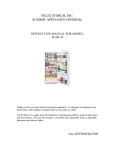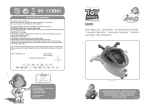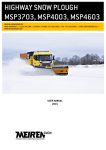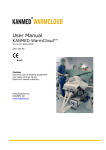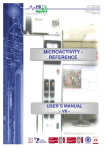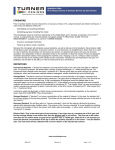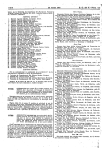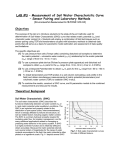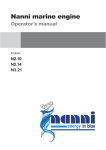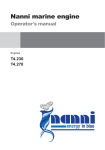Download USE AND OPERATING INSTRUCTIONS IMC TOYS products
Transcript
USE AND OPERATING INSTRUCTIONS IMC TOYS products undergo strict production controls to guarantee the enjoyment and safety of your children. They are easy to use and operate. We are certain that they will provide your children with great entertainment. Thank you for purchasing one of our products. To consult our extensive product catalogue, please visit our web page at www.imc.es. PRODUCT FEATURES This product includes a small laboratory inside the character’s head, with which you can safely perform a number of experiments (it does not contain chemical substances or elements). Contents: D G H I F E K A J T L B N C T M V U P R O V S Assemble and disassemble of the Spider Lab-Play Set 2 550650-GB / 280611 550650-GB / 280611 3 Functions available (Container A and Tubes G, H, I and J) When the content of container A is poured out, it will follow the line to container C When the spatula is turned, the tubes will protrude abilities to do the experiments may vary in the same age group. Perform only the experiments in this manual, and follow the instructions provided. SAFETY RULES Warnings! Caution! - Not suitable for children under 3 years of age. It contains small parts which might be ingested by them. Choking hazard. - The lab-play set may only be used under the close supervision of an adult, who must have read the precautions to be taken in this manual. - Natural rubber latex balloon. It can cause allergies. - Deflated or burst balloons can cause suffocation or asphyxiation in children under 8 years of age. Adult supervision is required. Deflated balloons must be kept out of reach of children. Burst balloons must be disposed of immediately. - Please read the instructions before use. Follow them and save them for future reference. - Avoid contact with the substances used and the body, especially the eyes and mouth. - Keep small children and animals away from the experiments. - Store the lab-play set out of reach of small children. - Please keep the packaging for future reference as it contains very important information. - Please note that due to technical improvements this product may differ from the one that appears in the illustration. MAINTENANCE To maintain the product and its parts correctly, remember to wash all items used with soap and water and dry them completely after every test or experiment before putting them away. NOTE FOR ADULTS Adult supervision is required while conducting the experiments. * The product contains no chemical substances and not all items required to conduct the experiments are included in the product. These items are every-day items, such as water, vinegar, lemon, toothpicks, glasses, etc. It does not include protective equipment (gloves or goggles), because the items used and the experiments are considered safe and do not require special protection. Even though the experiments included in this product can be considered safe, this does not mean that children should be left unsupervised or should not be monitored during play. ADULT SUPERVISION Read the instructions before use, follow them and keep them for reference. This product it is recommended for children over 8 years of age. The supervising adult is responsible for determining which experiments are suitable and safe for the specific child according to his or her skills, because children skills and 4 550650-GB / 280611 RECOMMENDATIONS FOR RESPONSIBLE USE AND FOR PROTECTING THE ENVIRONMENT Put all the transport packaging, cardboard, plastic, etc, in the recycling containers in your neighbourhood. Use rechargeable batteries whenever possible. Remember to turn off the toy if you have finished playing with it and take out the batteries if you are not going to be using it again for a long time. If you no longer want the toy and it still works, do not throw it away. Remember that other people can still enjoy it, and find bodies or associations that can give it to them. At the end of the life span of this product, it must not be disposed of as normal household rubbish. It should be delivered to a collection point for recycling electrical and electronic devices. Consult the symbol on the product, in the user manual or on the packaging for more information. The materials are recyclable in accordance with their markings. If you recycle materials or find ways to reuse old devices, you make a considerable contribution to protecting the environment. Please consult the nearest recycling centre or local authorities. 550650-GB / 280611 5 Table of Contents 1 Soap Solution 1 2 3 4 5 6 7 8 9 10 11 12 13 14 15 16 17 18 19 20 21 22 23 24 25 26 27 28 29 30 31 32 33 34 35 36 37 38 39 40 41 42 43 Objective of the experiment: Discover how different solutions have different properties. Also discover how the dissolution of a solid causes the links of the crystal lattice to break up and causes the subsequent breakdown of the components of the solid in the liquid. 6 Soap Solution.......................................................................................7 Bubbles with a Funnel.........................................................................8 Soap bubbles inside one another........................................................9 Clean old coins with vinegar..............................................................10 Dissolve an egg shell using vinegar....................................................11 Dissolve the shell of a hard-boiled egg using vinegar.......................12 Separation by cold..............................................................................13 “Age” a newspaper.............................................................................14 Gelatine rubber...................................................................................15 Gelatinous spider (inedible)..............................................................16 Floating egg....................................................................................... 17 Moving toothpicks.............................................................................18 Water and volume...............................................................................19 Secret messages on glass...................................................................20 Thread on soap...................................................................................21 Electrostatic balloon...........................................................................22 Drying a carrot................................................................................... 23 Hovercraft.......................................................................................... 24 Fun fountain.......................................................................................25 Air pump............................................................................................26 Spider-Man web.................................................................................27 Figure tracing.................................................................................... 28 Make a lentil grow.............................................................................29 Gravity water dispenser.....................................................................30 Cork dispersion...................................................................................31 Trained snake.....................................................................................32 Coiled snake........................................................................................33 Rocket balloon....................................................................................34 Poke a balloon with a needle.............................................................. 35 Make the spider jump with sound.......................................................36 Freeze a spider....................................................................................37 Ice that deforms plastic......................................................................38 A balloon that blows itself up...........................................................39 Telephone, sound transmission.........................................................40 Ice and thread stick to each other with salt......................................41 Why does an iceberg float?................................................................ 42 The coin that falls............................................................................... 43 Invisible ink.......................................................................................44 Water arch..........................................................................................45 The tissue stays dry...........................................................................46 Water in suspension............................................................................47 Saturated solutions and temperature as a variable...........................48 Aquatic music.....................................................................................49 550650-GB / 280611 Materials used: Container A and cap Container C Spatula B 15 ml of non-concentrated, washing up liquid (not included) Approximately 10 grams of sugar (not included) Approximately 10 grams of honey (not included) 150 ml of tap water (not included) 1 plastic straw Process: Prepare the following solution in container A: Step 1 Step 2 Add the sugar to 50 ml of tap water, and mix it using spatula B. Put the contents into container C. Do not allow to overflow. Carefully put the straw into the solution, and blow gently and continuously through the straw to get the largest possible bubble on the surface. Clean the materials with water, and follow the same process using the other two solutions. Analysis of the experiment: See which of the solutions is more elastic and which one has the molecules that form the strongest link, which will be determined by the size of the bubbles. 550650-GB / 280611 7 2 Bubbles with a Funnel 3 Soap bubbles inside one another Description: The objective is to make soap bubbles of different sizes using a funnel. Materials used: Soap solutions used in experiment number 1 Container C Funnel R 15 ml of non-concentrated, washing up liquid (not included) 150 ml of tap water (not included) Pipette Process: Make up 20 ml of soap solution. Step 1 Step 2 Put it in container C (Fig. 1), and submerge the wide part of the funnel in the solution. Remove it carefully and blow through the narrow end. A large bubble will form slowly. Step 3 Description: The objective is to put one soap bubble inside a larger one. Materials used: Soap solutions used in experiment number 1 Container C Funnel R Straw Process: Make up 20 ml of soap solution. Put it in container C (Fig. 1), and submerge the wide part of the funnel in the solution. Step 2 Step 3 Step 1 Remove it carefully and blow through the narrow end. When the bubble is the size you want (remember that it has to be big enough so that another bubble can fit inside), cover the narrow end of the funnel with your finger. Now take the straw, and dip the tip in the soap solution. Carefully insert the tip of the straw inside the bubble that you previously created, and blow gently on the other end of the straw. This will create another bubble inside the first one. Analysis of the experiment: With patience and skill, you can make bubbles inside bubbles. You can also pour a little soap solution on an waterproof surface, create a bubble there and then blow other bubbles inside the first one. You can make some very interesting geometric shapes. Analysis of the experiment: You can use various items to create different bubbles according to the air flow and the size of the surface area affected by the flow. 8 550650-GB / 280611 550650-GB / 280611 9 4 Clean old coins with vinegar 5 Dissolve an egg shell using vinegar Description: The objective is to use the acid created by mixing vinegar and salt to clean metal coins. Description: The objective is to dissolve an egg shell given that the calcium in the shell dissolves when it comes into contact with an acid such as vinegar. Materials used: Container A Plates D, E and F A copper coin (not included) 5 grams salt (not included) Pipette 15 ml vinegar (not included) Process: Put 5 grs of salt in Container A. Measure 15 ml of vinegar, and add it to the container with the salt. Mix well. Place the coins in the solution and leave them there for two hours. Step 1 Materials used: Container A Plates D, E and F Vinegar (not included) Egg shells (not included) Process: Put some egg shells into Container A, and add vinegar until the shells are covered. Wait two days and then check the shells. You’ll see that they’ve disappeared. Step 1 Step 2 Step 3 Analysis of the experiment: Another example of the effect that some substance has on another. In this case, calcium is lost in the reaction and the shells decrease in size. Use the tweezers to remove the coins from the container, and rinse them with water. Analysis of the experiment: Depending on the characteristics of elements and their mixtures, they have different reactions and different properties. In this experiment, what actually occurs is that the copper reacts with the mixture, and during the process, part of the copper on the surface is lost. The copper that has not been in contact with air is then exposed, and that’s why it looks clean and clear. 10 550650-GB / 280611 550650-GB / 280611 11 6 Dissolve the shell of a hard-boiled egg using vinegar 7 Separation by cold Description: The objective is to for the calcium in the egg shell to dissolve when it comes into contact with an acid such as vinegar. Materials used: Container A Plates D, E and F Vinegar (not included) Hard-boiled egg (not included) Process: Ask an adult to make a hard-boiled egg. Place it in container A and add vinegar until the egg is covered. Wait two days and then check it. Step 1 Description: The objective is to observe how two, mixed liquid elements of different densities separate according to the conditions, in this case a cold temperature. Materials used: Container A Water (not included) Orange juice (not included) Process: Fill container A half full of water. Fill the other half with orange juice, and mix well until the entire mixture looks like juice. Now place the container in the freezer and leave it there for two hours. You’ll see that when it freezes the orange juice goes to the bottom of container and the water stays at the top due because juice is denser than water. Step 1 Analysis of the experiment: The same as the example above, but more visual because the egg can be seen. In this case, the egg shell is also weakened by the reaction. * IMPORTANT! Caution! The hard-boiled egg must discarded and must not be eaten. The hygiene conditions do not make it suitable for use. 12 550650-GB / 280611 Analysis of the experiment: Materials, in this case liquids, behave in different ways according to their characteristics and on the environment to which they are exposed (temperature, pressure, etc.). 550650-GB / 280611 13 8 “Age” a newspaper Description: Observe how newspaper changes colour. 9 Gelatine rubber Description: The objective is to create rubber using edible gelatine. Materials used: Container C 5 grams edible gelatine powder (not included)* Water (not included). Pipette Tweezers Spatula B. * Approximately half of a typical envelope used for cooking at home. Materials used: Transparent drinking glass (not included). Pieces of newspaper (not included). Process: Put pieces of newspaper in a clear drinking glass, and leave it in the sun for 2 or 3 days. You’ll see how the newspaper turns yellow when exposed to the sun. This is due to the fact that sheets of newspaper are originally yellow before several chemical products are added to make them white. When exposed to the sun, the chemical products disappear, and the paper goes back to its original colour. Step 1 Process: Put a couple of grams of gelatine in the hexagonal container. Using the dropper, put a drop of water in the centre of the container. Add a second drop, and wait for the gelatine to dry. You’ll see that the texture of the gelatine changes when it comes into contact with the water. Keep doing this, drop by drop, until a gelatinous mass is formed. Step 1 Gelatine Analysis of the experiment: The effect by the sun and solar radiation on elements varies according to the element and the level of solar radiation. Do the same experiment in different seasons (winter, summer). See how much time elapses. You can also use magazines, which are more durable and take longer to age during the degradation process. Step 2 Gelatine You’ll see that material similar to rubber is formed, but made of gelatine, which you can take out with the tweezers. * If you want to do the next experiment (number 10), keep the non-solidified or unused gelatine. Analysis of the experiment: Gelatine is what we call a complex protein, in other words a polymer composed of amino acids. One of the characteristics of this molecule is its behaviour at different temperatures: visually it seems to dissolve in hot water, but it solidifies again with cold water, forming that gelatinous texture we all know. * IMPORTANT! Caution! Although edible gelatine is used, do not eat it, because plastic elements that have come into contact with are not intended for use with food and the environment does not meet hygiene conditions. 14 550650-GB / 280611 550650-GB / 280611 15 10 Gelatinous spider (inedible) 11 Floating egg Description: Create a gelatine spider. Description: The objective is to observe changes in the density of a solution containing a solid. Materials used: Container A Mould covers N and O Mould P 5 grams edible gelatine powder (not included)* Hot and cold water (not included)* Tweezers * Remember to recover the content from the preceding experiment (9) if you did it Process: Assemble the mould on some of the covers. Put the powdered gelatine on the mould, and distribute the content evenly inside, without allowing it to overflow. Do not put in too much product, the figure will not come out of the mould correctly. Cover with the other mould cover, ensuring that the ensemble is closed correctly. Fill container A with hot water, and place the ensemble in the container. Wait 2 to 4 minutes, and then remove the hot water from the container. Do not remove the mould, and make sure it moves as little as possible. Refill the container with cold water. Step 2 Step 1 Step 3 Materials used: Container A Water (not included) Spatula B Egg (not included) Plates D, E and F Process: Fill container A with water, and add a whole uncooked egg. The egg will sink to the bottom. Now use a spoon to add salt to the water that contains the egg. Step 1 The egg will begin to rise until it floats. This is because by adding salt to the water, you have changed the density of the water and made it denser than the egg. Step 2 Step 3 Wait for about 15 minutes with the ensemble submerged. Remove the mould ensemble from the water, and allow it to dry about 10 minutes before opening the mould. Carefully remove the figure. Be particularly careful not to break the legs. This will be easier if you use the tweezers. Now you have created a gelatine figure. Analysis of the experiment: As it was explained in the experiment above, gelatine has properties that make it suitable for moulding and creating shapes. This is how the gummy-bears we all know are made. * IMPORTANT! Caution! Although edible gelatine is used, do not eat it, because plastic elements that have come into contact with are not intended for use with food and the environment does not meet hygiene conditions. *WARNING! Hot water / heat source can cause burns, please handle with care. 16 550650-GB / 280611 Analysis of the experiment: The physical characteristics of an element determine its behaviour depending on the characteristics or composition of the element with which it interacts. In this case, the salt makes the egg float in the liquid, although the density of the egg has not changed. 550650-GB / 280611 17 12 Moving toothpicks 13 Water and volume Description: The objective is to observe the changes in the surface tension of water. Description: The objective is to observe changes in water volume. Materials used: Container C Water (not included) Toothpicks (not included) Sugar cube (not included) Bar of soap (not included) Tweezers Process: Fill container C with water. Break the toothpicks in half, and float them on the surface of the water. Use the tweezers to place the sugar cube in the centre. Step 1 Step 2 The toothpicks will move towards the sugar cube as it absorbs the water around it. Now repeat the experiment, this time with a piece of the bar of soap instead of the sugar. This time the effect is the opposite because the soap dissolves and spreads over the water. Step 3 Materials used: Test tubes H, I, J and G Water (not included) Process: Assemble the 4 tubes to obtain a long test tube. Fill it half full of water, check the level, and freeze. Step 1 Once frozen, look at the level again. It will have risen. Step 2 This is because water increases in volume when frozen. If you thaw it, the water will return to its original level. Analysis of the experiment: When the sugar cube absorbs the water it creates surface traction that draws the toothpicks floating on the surface towards it. In contrast, as the soap dissolves it tends to create a pushing force on the surface. 18 550650-GB / 280611 Analysis of the experiment: Elements – whether solid, liquid or gas – undergo changes in volume and even changes in their state according to temperature and pressure conditions. In this case, when the water solidifies, it expands and increases in volume. 550650-GB / 280611 19 14 Secret messages on glass 15 Thread on soap Description: The objective is to create secret messages on a glass surface. Description: See the effect of surface tension. Materials used: Container C Water (not included) 15 ml of non-concentrated washing up liquid (not included) Cotton bud (not included) Pipette Spatula Process: Put a little liquid soap in container C, add water and stir slowly. Step 1 Step 2 Submerge the cotton bud in the mixture, and use it to write a message or do a drawing on a piece of glass or a mirror. Now exhale hot breath on the glass or mirror, and the message will be perfectly legible. Materials used: Container C Water (not included) 15 ml of non-concentrated, washing up liquid (not included). Thread Pipette Process: Fill the hexagonal container with water. Tie the ends of a piece of thread and place in the container. Step 1 Place two drops of liquid soap in the centre of the shape created by the thread, as shown in the example. Step 2 Analysis of the experiment: In this case, the mixture acts as a barrier on the surface of the glass, and stands out from the rest of the surface when it comes into contact with breath of steam. Analysis of the experiment: The thread will expand into a circle as the soap breaks the surface tension of the water. 20 550650-GB / 280611 550650-GB / 280611 21 16 Electrostatic balloon 17 Drying a carrot Description: Observe the effect of static electricity. Description: See how some elements absorb water, in this case salt. Materials used: Container A Salt (not included) Carrot (not included) Materials used: Pieces of paper (not included) Balloon Process: Use scissors to cut up a sheet of paper into a lot of small pieces and spread them on a table. Blow up the balloon from the play set. Now rub it against your shirt or a textile cloth (wool is best), and hold the balloon close to the pieces of paper. The balloon will attract the pieces of paper. Process: Put a fresh carrot into container A. Now add a couple of spoonfuls of salt, and let it stand for a day. The next day the carrot will be much more wrinkled and dry because the salt will have absorbed the water from inside the carrot. Step 1 Step 1 Step 2 Analysis of the experiment: Generally speaking, atoms have the same number of electrons and protons. This means an atom has no electrical charge, it is “neutral”. However, when some materials are rubbed together, the electrons move from one atom to another. Some atoms then get extra electrons, and have a negative charge. Other atoms lose electrons, and have a positive charge. When charges are separated like this, it is called static electricity. As elements return to neutral, according to their charge they create an attraction, in this case the balloon to the pieces of paper. Little by little, the balloon loses ability to attract as it returns to a neutral state without a charge. 22 550650-GB / 280611 Analysis of the experiment: Salt has a dehydrating effect and absorbs water from objects that it surrounds, in this case the carrot. Thanks to the properties of some substances such as salt, Man has found ways to preserve foods, such as what we call salting. 550650-GB / 280611 23 18 Hovercraft 19 Fun fountain Description: The pressure caused by a stream of air released by a balloon can hold up a block. Description: Fluids: communicating vessels principle. Materials used: Disk K Mast L Balloon Process: Connect the pieces as shown in the image. Blow up a balloon and place it at the top of piece L, holding the neck of the balloon to stop the air from escaping. Step 1 Step 2 Materials used: Container M Straw (not included) Water Process: Put a straw through the hole and in the right direction as shown. Be sure that the bend of the straw is inside container M. Step 1 Step 2 Place the disk on the floor or on the smoothest possible surface, and connect piece L with the balloon to the disk. Release the neck of the balloon. You will see how the disk lifts a few millimetres off the surface. You can push the ensemble manually or blow on it so that it slides in any direction. Fill the container with water. You will see that the water will not start to fill the straw until it reaches the approximate height of the bend. Once past the bend, stop filling the container and it will empty completely. Analysis of the experiment: Pressure means that the air stored in the balloon leaves through the only point where it can. The air comes out at high pressure, causing it to push up when the air hits the surface, creating an “air cushion” effect. This lifts the ensemble a few millimetres allowing it to glide over the surface. Analysis of the experiment: The effect known as the communicating vessels principle is caused by what we call hydrostatic pressure, which is the effect of pressure on fluids. 24 550650-GB / 280611 550650-GB / 280611 25 20 Air pump 21 Spider-Man web Description: Contraction of hot air creates negative pressure that is capable of absorbing water. Description: Assemble Spider-Man’s web. Materials used: Container A Tubes H, I and G Container M Hot water (not included) Cold water (not included) Process: Set up the tubes as shown in the illustration. Fill container M with cold water. Fill the interior of container A with hot water to heat up the container. Step 1 Step 2 Analysis of the experiment: This is another effect involving pressure and temperature. In this case, heating container A causes the air it contains to expand. In other words, the pressure inside is lower than that in M. When container A cools, it creates a suction effect until the pressures inside both containers are the same. *WARNING! Hot water / heat source can cause burns, please handle with care. 550650-GB / 280611 Process: Take the 5 V-pieces of Spider-Man’s web and assemble using the central U-piece. Once connected, they should form a pentagon. Step 1 Step 2 Step 3 Then pour out the hot water from container A, and immediately put on the cap with the tubes already attached. Place the tube in container M, and observe how the water goes up to container A. 26 Materials used: V-pieces of Spider-Man’s web U-piece or centre of Spider-Man’s web String Run a piece of string through the plastic supports to form a web like the one in the image. Analysis of the experiment: Nature offers researchers useful items to analyse. There are spiders capable of weaving spider webs of differing complexities with materials whose strength and elasticity are, even today, a true challenge for man. 550650-GB / 280611 27 22 Figure tracing 23 Make a lentil grow Description: Trace Spider-Man’s silhouette with paper and pencil. Description: Growing lentils. Materials used: T-Spider-Man figures Paper (not included) Pencil (not included) Process: Use one of the Spider-Man figures. Place the figure under a sheet of paper. Step 1 Step 2 Materials used: Container M cover Cotton wool (not included) Lentils (not included) Water (not included) Process: Take the cover of container M, and place a little of cotton wool inside on which to grow your lentils. Place 3 or 4 lentils inside the cotton wool, and water them every day. The cotton wool should always be moist, but the water shouldn’t be visible. If necessary, remove excess water by tipping the cover, being careful to keep the cotton wool and the lentils from falling out. In a few days, plants will start to grow inside the cotton wool. Step 1 Use a pencil and rub the tip over the figure. Spider-Man’s silhouette will appear on the paper. Analysis of the experiment: The figure actually appears because of the roughness of the surface of the T-piece. The graphite in the pencil hits the irregularities of the piece harder, and the irregularities are therefore more visible on the paper. 28 550650-GB / 280611 Analysis of the experiment: Man has discovered ways to make plants and animals grow outside of their natural environment. The moisture contained in the cotton wool activates the seed as if it were in soil. However, neither the water nor the cotton will give it the nutrients it needs to survive. If you want the plant to continue growing, you should transplant it into a pot with soil. Plant research like this makes it possible to analyse plant growth in a lab and to find ways of improving production of plants for food or for industrial or medicinal use. 550650-GB / 280611 29 24 Gravity water dispenser 25 Cork dispersion Description: Gravity water dispenser. Description: Soap moves water with cork particles. Materials used: Container A Tube W Container M Water (not included) Vessel or container for collecting water (not included) Process: Fill container A with water up to the top, and fill container M, uncovered, to the height shown in the illustration. Step 1 Cut the tube to obtain a 6.5-cm long piece and another 9-cm long piece. Insert the tubes in the holes in the cover of container M, as shown in the illustration. Cover container M, and keep the tubes facing upwards so as not to spill the water. Turn container M upside down so that the shorter length of tube outside it goes inside container A, as shown in the illustration. Materials used: Water (not included) Container C Cork (not included) Washing up liquid (not included) Process: Break up the cork into the smallest possible pieces. Fill container C with water. Sprinkle the cork pieces so that they float on the surface. Touch the centre with a drop of soap, but don’t stir. You’ll see how the small pieces of cork move away. Step 1 Analysis of the experiment: The reaction between different liquids, depending on their composition, can be seen thanks to the help of additives, colorants or solid objects on liquids. Analysis of the experiment: See how water is sucked up by the long tube and dispensed by the short one. This is because fluids behave differently under different pressure conditions, which in this case is different in each container. This is called hydrostatic pressure. 30 550650-GB / 280611 550650-GB / 280611 31 26 Trained snake 27 Coiled snake Description: The magnetic charge of a pen attracts a snake. Description: Observe effect of convection and how rising hot air causes the spiral-shaped snake to spin. Materials used: Scissors (not included) Paper (not included) Pen (not included) Thread Wool cloth (not included) Process: Draw a snake in the form of a spiral so that the head is pointed and is located at the outside part of the spiral. Cut it out and make a hole in its tail, which is in the centre of the spiral. Materials used: Scissors (not included) Paper (not included) Pencil (not included) Thread Process: Draw and cut out a spiral. Make a hole in the centre and run some thread through it (you can use the snake made in the preceding experiment). Step 1 Step 1 Run a piece of thread through the snake’s tail, and tie a knot in the thread. Hang up the snake and rub the pen against the wool cloth. Move the pen around the snake, and the snake will follow. Analysis of the experiment: This is another experiment involving to electrical charges. In this case, rubbing the pen with the cloth gives it an electrical charge. This happens because the materials that are rubbed together have different capacities to retain and transfer electrons and when they touch some electrons jump from one surface to the other. An electrically charged body will try to offset its charge. In this case, the snake is attracted by the electrically charged pen. 32 550650-GB / 280611 Step 2 Step 2 Put a knot in the thread at the bottom of the spiral. Hold the thread and place the spiral over a source of heat. Analysis of the experiment: The so-called convection effect shows how heat is transferred. If a liquid or gas, in this case gas (air), is in a gravitational field, the hottest fluid or gas rises because it is less dense, while the colder fluid or gas descends because it is more dense. This type of movement, due exclusively to the non-uniformity of the temperature of the fluid or gas, is called natural convection. *WARNING! Hot water / heat source can cause burns, please handle with care. 550650-GB / 280611 33 28 Rocket balloon 29 Poke a balloon with a needle Description: Convert the balloon in a rocket with the force of air. Description: Reinforcement of the zone where a hole means that the balloon doesn’t burst. Materials used: Clip (not included) Adhesive tape (not included) Balloon Thread Tube H (2) Process: Step 1 Materials used: Balloon Transparent adhesive tape (not included) Sewing needle (not included) Thread Process: With the balloon deflated, put adhesive tape on one side, and then do the same thing on the opposite side so that when the balloon is pierced by the needle the places with the adhesive tape are in line. Thread the needle with the string. With the threaded needle, pierce the two zones with the adhesive tape, thus running the thread through the balloon. Step 1 Step 2 Blow up the balloon and seal it with the clip so that no air comes out. Use adhesive tape to stick two or more tubes H to the balloon in a straight line. The two tubes must be in line. Run the thread through the tubes and tighten the thread. You can tie one end to a door knob and simply hold the other end or tie it to something else. Step 2 Remove the needle, leaving the thread through the balloon. Blow up the balloon quickly. The balloon will lose air slowly, but it will not burst. Move the balloon so that the clip is at one end of the thread. When you remove the clip, and the balloon will take off following the thread. Analysis of the experiment: The balloon does not burst and the walls of the balloon won’t collapse because of the adhesive tape, which holds the walls together. Analysis of the experiment: Actually, rockets are lifted and moved using the same principle of gas expulsion. In this case, the air has been concentrated inside a balloon. While the mouth of the balloon is closed, the air pressure inside the balloon is the same in all directions. When opened, the pressure inside the balloon is lower at the open end than at the opposite end, causing the balloon to take off. 34 550650-GB / 280611 550650-GB / 280611 35 30 Make the spider jump with sound 31 Freeze a spider Description: We can use vibration to make the spider jump. Description: Freezing a liquid. Materials used: Container A (not included) Piece of fabric (not included) Rubber band (not included) Spider figure Wooden spoon (not included) Saucepan (not included) Process: Cover container A, with a piece of fabric over it. Using a rubber band, tighten the piece of fabric, and put the spider figure on it. Bang on a large saucepan with a wooden spoon or spatula with the open part towards container A. Materials used: Container A Water (not included) Spider figure Process: Place the spider figure in container A, and fill with water to the top. Step 1 Step 2 Step 1 Put in the freezer until frozen, then remove the ice from container A. You can run a little hot water on the outside of the container to help release the ice contained inside. Observe the figure inside. Analysis of the experiment: Pressure, humidity and temperature changes in the environment cause the molecules that make it up to move. Each molecule transmits vibration to its neighbouring molecule, thereby causing a chain of movement. These coordinated movements of millions of molecules cause so-called sound waves, which cause the sensation described as sound in the human ear. Here, this vibration is concentrated on the textile surface, thus causing it to move. 36 550650-GB / 280611 Analysis of the experiment: “Ice” is frozen water. It is one of the three natural states in which water is found: gas, liquid or solid. Pure water freezes at 0º C at sea level. In this case, a variation in the freezing point can be caused by pressure differences depending on the altitude and the composition of tap water. In this experiment, we can simulate how a liquid medium, when it becomes a solid, can trap and contain elements, in this case a solid. 550650-GB / 280611 37 32 Ice that deforms plastic 33 A balloon that blows itself up Description: When air cools inside a bottle, the interior pressure decreases, and the exterior pressure deforms the bottle. Description: By heating the air inside a balloon, it expands and blows up the balloon. Materials used: Plastic bottle with a cap (not included) Ice (not included) Process: Take some ice, and crush it until it can be put inside the bottle. To do this take an ice cube, wrap it in a cloth, and hit it with a wooden mallet, or use a blender designed to crush ice. Put the ice inside the bottle, and make airtight with the cap. Shake the bottle so that the ice comes into contact with the walls of the bottle and cools the bottle entirely. The bottle will contract and deforms. Materials used: Balloon (you can use the balloon contained in the play set, as long as you haven’t done experiment number 36) Washbowl (not included) Water (not included) Process: Take a balloon and blow it up just a little bit, enough so that the balloon’s walls aren’t touching. Tie off the opening, and place the balloon over a washbowl with hot water. As the air inside the balloon heats up, it will expand and blow up the balloon. Step 1 Step 1 Analysis of the experiment: The ice causes a sharp reduction in the air temperature inside the bottle, causing it to reduce in volume. Because the bottle sealed and airtight, it cannot compensate for the pressure. The outside air presses on the walls and crushes them due to the different pressures. In this case, the pressure inside the bottle is lower than the outside air pressure, and the plastic material is not capable of withstanding the outside pressure and becomes deformed. All bodies except water contract when they cooled. 38 550650-GB / 280611 Analysis of the experiment: In this case, heat causes the air molecules contained inside the balloon to expand, thereby pressing on its walls. Since the walls are elastic and flexible, they allow the balloon to expand and grow in volume. *WARNING! Hot water / heat source can cause burns, please handle with care. 550650-GB / 280611 39 34 Telephone, sound transmission 35 Ice and thread stick to each other with salt Description: Sound (sound waves) is transmitted through a solid. Description: Trap a thread inside an ice cube. Materials used: 2 plastic cups or empty containers similar to yoghurt containers (not included) Needle (not included) Thread Process: Take one of the plastic containers, and perforate it using the needle. Be careful with your fingers. Send the thread through the hole and tie a knot in the end inside so that the thread can’t be pulled out. Step 1 Materials used: Ice cube (not included) Thread Salt (not included) Plate (not included) Process: Take an ice cube out of the freezer and leave it on the plate. Take the thread, and place it on the top surface of the ice cube. Sprinkle a little bit of salt on the ice cube in the zone where the string and the ice cube touch. With your finger, gently rub the salt on the thread and the ice cube, being careful not to move the thread. Wait a few minutes, and the thread will be stuck to the ice cube. Step 2 Step 1 Follow the same steps with the other container, and tie a knot in the other end of the thread. Pull the thread taut by pulling the containers away from each other. Speak through one container and listen at the other end. Analysis of the experiment: The speed at which sound waves are propagated depends on the characteristics of the medium through which that propagation takes place and not on the characteristics of the wave or of the force that generates it. The speed of sound is the propagation speed of sound waves. In Earth’s atmosphere, this speed is 343.5 m/s (at a temperature of 20º C). The speed of sound varies according to the medium through which it is transmitted. In this case, it is a solid medium, the string. The containers act as amplifiers of the signal. Note how the movement of the sound waves varies (and therefore the transmission of the sound) depending on how taut the thread is. 40 550650-GB / 280611 Analysis of the experiment: On the surface of ice cubes there is a layer of liquid water in equilibrium with the ice. By adding salt, part of the salt dissolves, thereby forming a saturated solution that breaks the equilibrium with the ice. To recover the equilibrium, the solution tends to dilute and the ice tends to cool. This is achieved by melting part of the ice, which gets the necessary heat to melt from the solution, which in turn cools below 0º C. It’s as if we had thawed it and frozen it very quickly so that when it freezes again, the thread remains trapped in the part affected by the salt. 550650-GB / 280611 41 36 Why does an iceberg float? 37 The coin that falls Description: The floatability of the solid state of water in the liquid state of water. Description: Destabilise a coin, making it wobble or fall. Materials used: Container A Water (not included) Ice cube (not included) Tweezers Process: Fill container A approximately half full. Take the ice cube and put it in container A. Notice how it floats. The entire volume that the water rises is the volume expanded by the ice. Step 1 Materials used: Container A Coin (not included) Process: Place container A in the refrigerator to cool the air inside. Take it out of the refrigerator, and place a coin over the opening, if possible a coin with the lowest possible weight. You must leave a little less than half of the coin hanging over the edge of the container. When the cold air inside heats up, its volume increases, which will cause the coin to move and even fall. Step 1 Analysis of the experiment: Because water expands when frozen, its density decreases, which makes it float. When water cools, its volume contracts, just like all bodies. However, when it reaches 4º C, contraction stops, and its structure expands until it transforms into ice at the freezing point. Water is one of the few substances that expands when it solidifies. Most substances contract in the solidification process. This explains why ice floats and why, in rivers, lakes and oceans, only the surface water freezes, which then acts as a thermal layer and allows underwater life to continue below. 42 550650-GB / 280611 Analysis of the experiment: In this case, we previously cool the air inside the container, which reduces the volume. When the container is taken out of the refrigerator, the air recovers its normal volume at room temperature. It therefore exerts pressure on the walls of the container. At its weakest point, the opening where the coin is placed, the air is able to expand outside, causing the coin to move. 550650-GB / 280611 43 38 Invisible ink 39 Water arch Description: Write invisibly in plain sight Description: The electrical charge of a spoon attracts the non-charged particles of water. Materials used: Container C Lemon juice (not included) Small brush (not included) Blank paper (not included) Process: Squeeze the lemon and use a small brush to write secret messages on a blank sheet of paper with the juice. When the writing dries it will become invisible. Step 1 Place the paper in the sun or close to a heat source (an incandescent bulb), and notice how the hidden message appears. Be careful not to get burned when placing the paper near a heat source. Step 2 Analysis of the experiment: The message appears because the solids contained in the liquid burn faster than the paper. You can also get the same result using milk or the juice of an onion. *WARNING! Hot water / heat source can cause burns, please handle with care. 44 550650-GB / 280611 Materials used: Metal spoon (not included) Wool cloth (not included) Water (not included) Process: Rub a spoon on a wool cloth. Turn on the tap and allow the thinnest possible stream of water to flow. When you take the spoon close to the water flow, note how it attracts the stream of water Step 1 Analysis of the experiment: When you rub the spoon on the wool surface, you are transfer electrical charges from one body to another, which causes that the spoon to be positively charged and the cloth negatively charged. This shows the interaction between charged particles. Because water is neutral, when you place the charged spoon close to the stream of water the charges inside the liquid reorganise themselves, forming a dipole – meaning that it has two electrical poles, one positive and another negative. This is due to the fact that the positive charges in the water are attracted by the negative charges of the spoon, while the negative charges of the water are repelled by the negative charges of the spoon. This means that the stream of water curves in the direction of the spoon, a product of the attraction between the negative charges of the spoon and the positive pole of the water. This interaction is described by Coulomb’s law. The curving effect of the water becomes stronger as the spoon is moved closer to the flow, without touching the water. 550650-GB / 280611 45 40 The tissue stays dry 41 Water in suspension Description: Water pressure gains on air pressure depending on the force or push to which the container is subjected. Description: The weight of water can be sustained by atmospheric pressure. Materials used: Paper tissue (not included) Container A Bowl or bucket with water (not included) Process: Wad up the tissue so that it can be put inside and will stay at the bottom of container A. Turn the container upside down that the opening is face down and the tissue doesn’t fall out. Now put the container into the water little by little without allowing the water to touch the tissue. You will notice some resistance. Notice how, as you apply more force/pressure, the water gains ground on the air contained in the container, which in turn causes the tissue at the bottom of the container to become more crumpled. This is due to the fact that the pressure exerted by the water is increasing, thus causing the air to compress. Materials used: Container A Water (not included) Tray E or cardboard (not included) Process: Fill container A with water until overflowing. Place piece E on the opening. Step 1 Put your hand on top of the piece, and turn the ensemble upside down. Slowly remove your hand, and note how the piece or cardboard remains attached to the container and that the piece holds the weight of the water. The pressure exerted by air on the cardboard piece is greater than the pressure exerted by the water. Analysis of the experiment: When the pressure increases, the volume decreases, and if the pressure decreases, the volume increases. This is called Boyle-Mariotte’s law, which also establishes a correlation between temperature and pressure. 46 550650-GB / 280611 Analysis of the experiment: By adding greater surface area in contact with air with piece E or the cardboard, the air pressure keeps the cardboard on the container and keeps the water inside. Atmospheric pressure is over one kilo per square centimetre of surface area, but we don’t notice it on our body. This is due to the fact that air exerts pressure in all directions (such as all fluids and gases), but the internal liquids of all living beings exert pressure that balances the external pressure. 550650-GB / 280611 47 42 Saturated solutions and temperature as a variable 43 Aquatic music Description: Depending on the temperature of a solvent, in this case water, we can dissolve more or less solute (sugar). Description: Depending on the mass of each glass, it vibrates one way or another. Materials used: Container A Water (not included) Sugar (not included) Spatula Process: Fill container A with hot water, and add a spoonful of sugar. Stir with the spatula, and see if the sugar dissolves. Continue to add sugar and count the number of spoonfuls of sugar you add until you see that the sugar cannot be dissolved and remains at the bottom. The solution has become saturated. Now perform the same operation, but with cold water. Notice how fewer spoonfuls of sugar can be dissolved than in hot water. Materials used: 6 glass cups or wine glasses (not included) Water (not included) Pencil (not included) Process: Fill 6 glasses with different levels of water, and arrange them on a surface according to the quantity of water, such as from more to less. Gently tap the different glasses, and you’ll hear that they produce different notes. Step 1 Step 1 Analysis of the experiment: You have seen that more sugar will dissolve in hot water, so by increasing the temperature of the water, we also increase dissolution capacity. If you dissolve sugar in hot water until the solution is saturated and until it will not dissolve any more sugar, you will see that as the water cools to ambient temperature, sugar is slowly deposited as sediment at the bottom. This occurs because as the temperature drops, the water’s dissolution value also decreases. 48 550650-GB / 280611 Analysis of the experiment: Sound moves by vibrations. Depending on the quantity of water and air contained in a glass, a different sound will be produced. Play with the quantities of water to get different musical notes. If you have a musical instrument, you can compare its notes to those obtained with the glasses and even make a musical scale. 550650-GB / 280611 49 550650 - GB SPIDER LAB-PLAYSET For any claim about its correct functioning, please contact with: IMC TOYS, S.A. • Pare Llaurador, 172 • 08224 Terrassa (Barcelona) España [email protected] • www.imc.es • NIF: A-08667370 Barbie and associated trademarks and trade dress are owned by, and used TM & © 2011 MARVEL under license from Mattel, Inc. © 2007 Mattel, Inc. All rights reserved. Made in China INSTRUCTIONS FOR USE 280611

























